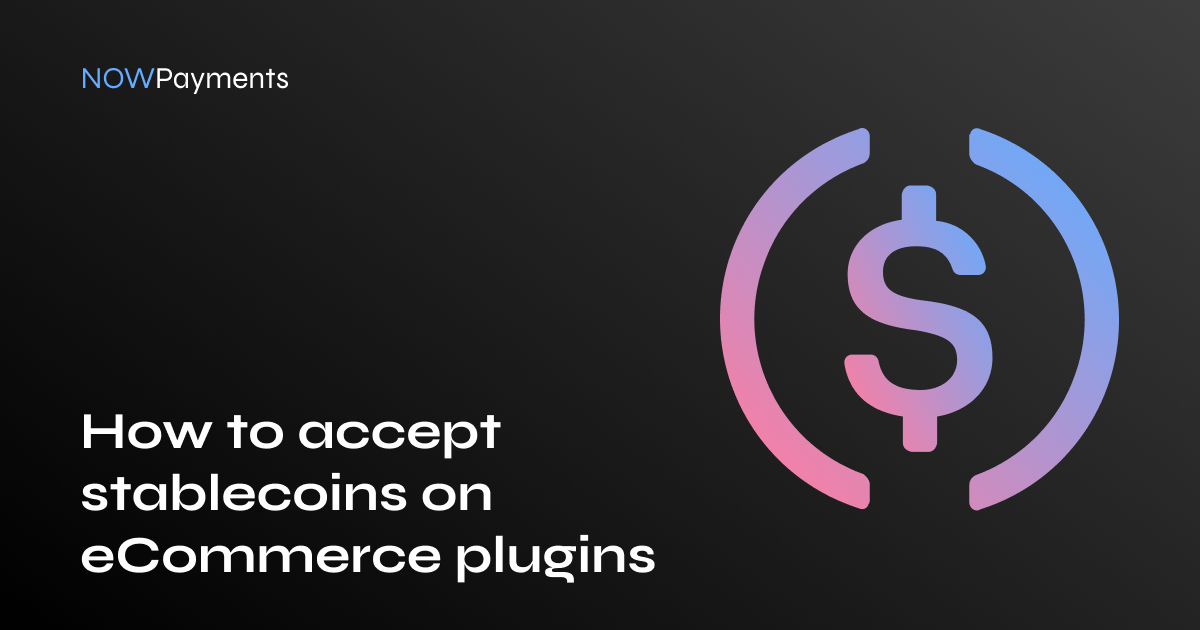Stablecoins are a unique type of digital asset that retains the advantages of traditional cryptocurrencies, minimizing their main disadvantage — volatility. We invite you to find out how stablecoins can help your e-business and how to start accepting payments via NOWPayments plugins.
Key Points:
- Stablecoins are the best choice for merchants who value stability.
- There are three types of stablecoins: fiat-backed, crypto-backed, and algorithmic.
- NOWPayments provides plugins for accepting stablecoin payments on leading CMS platforms.
What is good about stablecoins?
Stablecoins are digital assets designed to bring stability to the crypto market. The rate of a stablecoin is pegged to a fiat currency, most often it is the US Dollar, in a ratio of 1 to 1. Stablecoins have the same advantages as cryptocurrencies plus one more — they are not subject to such high volatility. Thus, among the main benefits of stablecoins are the following:
Perfect for commercial purposes
Even though cryptocurrency is gaining more and more recognition, not all merchants are ready to accept it for payment due to the risks associated with high volatility. Business owners strive to bring more stability to their activities; therefore, they avoid cryptocurrencies. Stablecoins are just those assets that minimize the impact of volatility, which makes them an excellent choice for making payments. In addition, stablecoins preserve the main advantages of cryptocurrencies — speed and low fees.
Stablecoins are created on the blockchain
Like other cryptocurrencies, stablecoins use blockchain technology to issue coins. This fact makes transactions with stablecoins more transparent and, at the same time, more secure than with traditional electronic payment systems. Thanks to the blockchain, users can send fast and low-fees payments regardless of their location. All you need to make a payment is a reliable crypto wallet and a mobile device/laptop. In addition, blockchain makes transactions with stablecoins irreversible, which is positive for merchants who do not want to experience chargeback fraud.
Can be used as a value preservation tool
Merchants who accept cryptocurrency for payment are forced to withdraw funds to their bank accounts in order to hedge the risks of volatility. A fairly common situation is when you receive, for example, $100 in BTC, and on the next day, you already have $85. And we have given an example with one of the least volatile cryptocurrencies. In this case, there is no one to turn to. Because, as we remember, cryptocurrencies are decentralized and users bear all the risks associated with volatility. In the case of stablecoins, merchants should not be afraid of losing profits due to the pegging to the fiat currency.
Types of stablecoins
To date, it is customary to divide stablecoins into three camps. Each type has its advantages and disadvantages that need to be weighed before choosing.
Fiat-backed
Fiat-backed stablecoins are the most common type. The pegging to the fiat currency is provided via reserves that the issuing company keeps in its bank accounts. The number of circulating stablecoins exactly corresponds to the number of fiat currency units in the company’s reserve. This approach makes the rate of fiat-backed stablecoins more accurate. In addition, this type of stablecoin is easy to use. The user simply pays $100 and receives, for example, 100 USDT. However, fiat-backed stablecoins are more centralized.
Crypto-backed
In response to the problems with the centralization of fiat-backed stablecoins, some companies created those that use cryptocurrency reserves to issue stablecoins. In the case of crypto-backed stablecoins, users need to deposit a predetermined amount of supported cryptocurrency in order to issue new stablecoins. This type of stablecoin is more decentralized, but it has some disadvantages. So, the amount of collateral is usually many times higher than the amount of coins received (for example, you deposit $150 in crypto as collateral and get $100 in stablecoin). To maintain a stable pegging, the amount required for the issue can either increase or decrease. For example, if the price drops below $1, additional fees are imposed on users, which motivates them to return the stablecoins. Thus, the circulating supply of coins decreases, pushing the price back to $1.
Examples: DAI.
Algorithmic
The most complex and rare type of stablecoins has not yet been widely recognized. Algorithmic stablecoins are not backed with either fiat or cryptocurrency. To maintain pegging, the protocol uses a rebase mechanism. In addition, these stablecoins differ in that they have an elastic supply. In practice, it looks like this: if the price of one unit of stablecoin exceeds $1, the rebase mechanism is activated and the circulating supply increases, thereby motivating the price to decrease. Conversely, if the price drops below $1, the rebasing mechanism reduces the number of circulating stablecoins, hence the price rises back. It is also worth noting that most often algorithmic stablecoins do not have a rigid binding, and their price can fluctuate in a given price range, for example, from $0.95 to $1.05.
Example: AMPL, OUSD.
How to accept stablecoins using plugins
NOWPayments supports leading stablecoins, such as USDT, DAI, USDC, BUSD, and others. If you are the owner of an online store, you can easily start accepting stablecoin payments using our easy-to-integrate plugins. Our service provides plugins for leading CMS platforms: Magento 2, OpenCart, Shopify, PrestaShop, etc. In order to start accepting stablecoins in your store, you need to perform the following actions:
- Log in to your personal NOWPayments account.
- Navigate to the “Store Settings” section.
- Add your payout wallet.
- Generate an API key.
- Choose the plugin that suits you.
- Download the plugin to your device.
- Log in to your commercial account.
- Activate the NOWPayment plugin.
- Receive profits!
FAQ
Conclusion
Stablecoins are universal digital assets that are perfect for e-commerce. Thanks to stablecoins, merchants can receive fast, low-fees payments from customers worldwide and not be afraid of losing profit on rate fluctuations.

